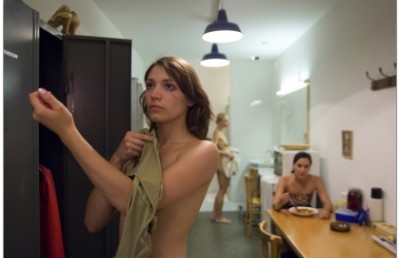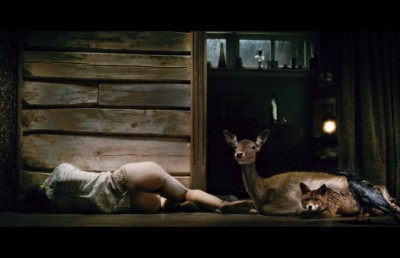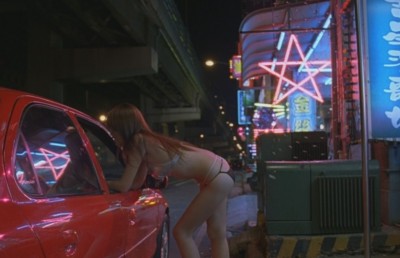Mon Oncle Antoine
A Truly Venerable Classic
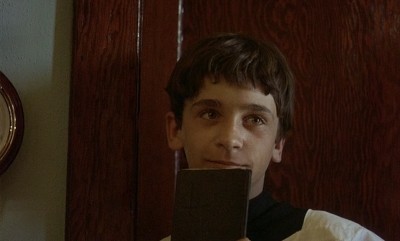
Claude Jutra’s Mon oncle Antoine (1971) is one of the most highly regarded Canadian films of all-time, a critical assessment which has not waned over the years since people have cared enough about Canadian film to think about canons. The film can be looked at, interpreted, and appreciated from a handful of perspectives –social/political, cultural, aesthetic/stylistic, historical– and normally requires that several of these perspectives be aligned to properly evaluate its contribution and lasting relevance to Canadian (and Québècoise) film history.
The most common reading of the film is to see it as representing a critical junction in the pre/post Révolution tranquille (Quiet Revolution),1 a film which depicts the era when the majority French Quebec people were second class citizens to the ruling class, the English, and the ultra conservative political party the Union National, which held power in Quebec from 1936-1939, 1944-1960, and 1966-1970, governed by the powerful Premier of Quebec from 1936-1939 and 1944-1959, Maurice Duplessis. The period ruled by the Union National is now referred to as the Grande noirceur (the Great Darkness). The Union National’s policies favored rural areas, opposed trade unions, and struck a tight governing bond with the Catholic Church (which also accounts for the party’s strong anti-Communism). In short, the Union National stood for everything that the Quiet Revolution would slowly, over the decades of the fifties, sixties, and seventies, overturn, oppose, or change. On the other interpretive hand, the film is not overtly political (though it clearly is for anyone with even a cursory knowledge of Quebec history), and to the ‘outsider’ fits more comfortably into the ‘coming of age’ genre (through the course of the film the adolescent Benoît comes to experience adult and Church hypocrisy, sexual indiscretions, and death and mortality). Of course, if taken figuratively, this speaks to a Nation’s ‘coming of age,’ as well as the twelve year-old boy named Benoît . Setting the film in the rural 1940s Quebec no doubt relates to this political reality and, more directly, to a series of strikes in 1949 and 1952 by asbestos miners in the Black Lake region of Quebec, which pitted French miners against the English mine owners and the Duplessis police. These strikes were seen as a “one of the first hotbeds of the political agitation and labor unrest that set the stage for the Quiet Revolution” (Leach, 137), and Claude Jutra had gone there as a student in a show of solidarity.
Because Mon oncle Antoine is such a canonized film in Quebec history and has received so much critical coverage, I thought I would approach the film in a less conventional manner, eschewing a linear/plot/interpretation/analysis approach for a more diachronic, schematic question/answer (Socratic?) approach which will, I hope, serve as both a primer for the uninitiated, while remaining fresh for the reader well versed in the film and its critical legacy.
What was filmmaking like in Canada at the time leading up to the making of Mon oncle Antoine ?
The victory of Jean Lesage’s Liberal Party in 1960 in Quebec was a sign of the changing times, signaled by the urge to be ‘maitres chez nous’ (masters of our house). This had a ripple effect on all sectors of Quebec life, including cinema. Quebec filmmakers wanted to tell stories about themselves, their culture, their people, and consequently fiction became the way to express this. In English Canada fiction features were pretty much none existent in the 1950s, with a handful of films only, but things changed in the 1960s (Don Haldane’s The Drylanders in 1963 was the first English language feature) with people like Larry Kent, Don Owen, Don Shebib, Peter Carter, Robin Spry, and Paul Almond making their first feature films. Although there was still an overall domination of documentary, there was also an increase in fiction. Meanwhile in Quebec a hatful of filmmakers were making their first feature fiction film: Claude Jutra (À tout prendre, 1964), Jean-Pierre Lefebvre (Le Revolutionnaire, 1965), Michel Brault (Entre la mer et l’eau douce, 19 68), Anne Claire-Poirier (De mère en fille, 1968), Gilles Carle (La vie heureuse de Léopold Z 1965), Jean-Claude Lord, Denis Heroux (Valérie, 1969), Gilles Groulx (Le chat dans le sac, 1964), Claude Fournier (Deux femme en or, 1970), Pierre Perrault (Pour la suite du monde, 1963), Jacques Godbout (YUL 871, 1968), and Denys Arcand (La Maudite Galette, 1972).
From 1961 to 1969 there were 50 feature films made in Quebec, which is more than double the total of 1944-53 (Melnyk, 126). According to George Melnyk, there increase can be attributed to three general factors:
1-The rise of the cinema d’auteur
2-The theme of liberation (French as an oppressed language in Canada); the post-war ‘anti-colonialist’ trend in France (losing Algeria, Vietnam) and in England (losing India, African countries)
3-The cinema direct influence is the ‘panoramique series’ at NFB gave filmmakers a license to interact with subjects, let them speak, etc. (Melnyk, 126-127)
Ok, what is the film about?
The film is set in mining town of Black Lake, in the asbestos mining region of Estrie, at Christmas time in the 1940s. The central characters are the Francophone members of the community; and the English, the mine owners, are essentially the villains of the piece. The central characters are shop owner Cécile (Olivette Thibault) and her husband Antoine (Jean Duceppe), the shop assistant Fernand (played by Claude Jutra); their adopted ‘nephew’ Benoît (Jacques Gagnon) and shop helper Carmen (Lyne Champagne), who incites Benoît’s sexual awakening; and woodcutter Jos Poulin, his wife Élise and their children. The film deals with both universal and particular concerns. On one hand it is a coming of age story, the young 14 year-old Benoît’s, which can be seen as a nationalist coming of age story as well. For a modern audience it represents a Quebec that they can and can’t recognize, the same (the past) and different (future).
Ok, so it is a good film. But why is this film significant in the history of Canadian film?
Along with the reasons cited above, Mon oncle Antoine synthesized the traditional nationalism of pre-World War 2/pre-Quiet Revolution film: “language, family, Catholicism, and rural life,” but showed chinks in the armor through the rebellious spirit of young Benoît (Jacques Gagnon). From a stylistic point of view, it moved away from the cinema direct style which was strongly identified as the cinematic voice of Quebec filmmakers, toward a style as much Jean-Luc Godard as Jean Rouch. It signaled the move away from French-Canadian to Quebecois identity. The film, set in the 1940s, may appear to be removed from this reality, as many Quebec critics thought at the time, but it subtly reflects this Nationalist movement/awareness, couched in an entertaining, ‘universal’ coming of age story. The film demonstrated that a Quebec film can at once have entertainment value and register important social and cultural meaning. This latter aspect is centered around the film’s indirect expression of the Quiet Revolution. As a coming of age tale, many people assume that the film should be seen through the eyes of young Benoît , but in fact he is not in the opening scenes of the film. The character who we first meet is blue collar worker Jos Poulin, who represents the bitterness and anger of the French working class, even though his reaction to his underclass status is one of impotence –to escape into the wilderness at a point where his family needs him the most. There is a key scene early in the film where Jos Poulin (Lionel Villeneuve) gets reprimanded for attempting to fix the ‘company’ truck by his English boss; the boss speaks in English, Poulin stares back in silence, and then when his son asks him what the boss said, he replies “I don’t know, I don’t speak English.” In fact he understood well what the boss said, based on what he first says to his son, but the point is that a) he does not want to give the boss the satisfaction of speaking to him in English and b) he doesn’t want his son to know that he speaks English. The scene recalls a well worn anecdote about the days of the ‘great darkness,’ which has attained the level of urban myth to Montrealers, about the little old French lady who goes into a large downtown department store, Eaton’s, and is served in English by the unilingual store clerk. Peter Black writes, “The ‘fat, damned English lady’ at the counter in Eaton’s who was unable to speak French, became the symbol of every store clerk, bank teller, construction foreman, plant manager, or taxi driver who at some point insulted or humiliated a francophone by not speaking their language. The story is no doubt based in a symbolic truth, but the anecdote is sure to raise a smile today because the invocation of any ‘little old lady’ being dismissed and unable to make herself understood, in any language, is sure to illicit sympathy. But to the generation of Francophones who lived through this period, the anecdote still holds a political resonance, one which the scene cited earlier clearly invokes. As such, the film depicted the first images of working class Francophones being humiliated by English bosses. As already noted, the mining setting is also relevant because it represents an important moment where politically motivated dissent came to the fore: workers against their Anglophone bosses. Jos Poulin is just plain angry and fed up with his generation’s lot: being subservient to the ruling class. As Jos urinates in the tavern’s toilet the graffiti on the wall may well have been written by him: “Duplessis my Ass”.
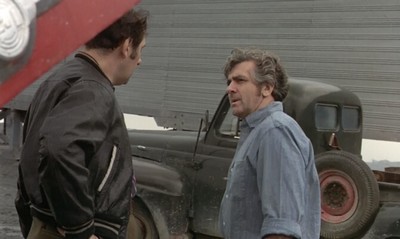
Favorite scenes / Moments?
Opening Scenes: The opening scenes are wonderfully edited and shot to establish a sense of place, while laying out theme and subtext. It starts with atmosphere, the deep Bible blacks, earthy colors, set against the white snow, usually set off by the dark clouds or night sky. Four minutes in we get the first of many symbolic edits. In extreme long shot the camera frames a mountain, belching forth the mine’s waste from its side, which cuts directly to the funeral of a miner, Euclide, a damning form of Eisensteinian intellectual montage. A few minutes later we get an early establishing scene which opens on another LS of a mountain housing a mine. Black smoke is coming out of the mountain’s side. The camera pans slowly to the right across the wintry landscape and to the town below, settles on a church, and then zooms in quickly to the church, the quickest of many zooms in the film. Hence in one continuous shot the film connects the mine, owned by the rich English owners, to the Church, which is helping to suppress the new Quebec. The mountain and church get their own prominent zoom moment. The zoom-in at the beginning is also connected to the funeral of a miner, Euclide, so there is a parallel between the mine and the early death of people who work there. The sense of death hovering over the film carries over into a tavern scene after Euclid’s funeral. Jos and a group of his friends share a drink to remember their deceased friend. As Jos raises his beer glass he says, “That’s another one the English won’t get,” which directly refers to the beer, but symbolically to himself, since he has decided to leave his mining job, and hence won’t die like other miners.
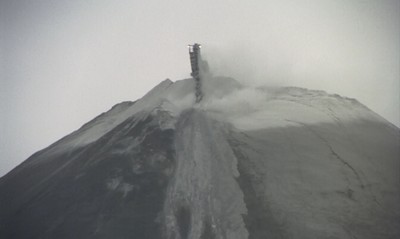
English boss delivering presents: The scene of the boss tossing cheap presents onto the street for kids to pick up like wild dogs is at first disheartening and then ends with a hint of rebellion. Benoît and Maurice throw snowballs at the horse, causing it to gallop off and make the man look foolish. Right after this moment there is an exchange of smiles between Benoît and Carmen, who have just earlier had a sexual encounter where Benoît fondled her breasts. As Jim Leach suggests in his book on Jutra, the smile invokes the possibility of “a new sexual and political freedom.”
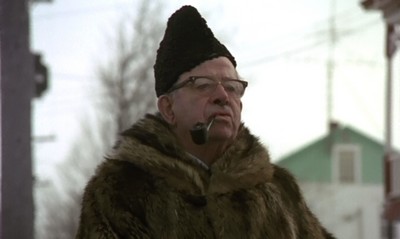
Dinner at Madame Poulin’s: Antoine and Benoît drive an empty coffin on a horse drawn sleigh through a cold, wintry night to the home of Madame Poulin to collect the corpse of her young son, Mario. When they arrive M. Poulin offers them a late night pork dinner. His actions are ill matched to the somber occasion, with the sorrow M. Poulin, who has just lost a son, sitting quietly at the side of the table, as Antoine carries on eating and drinking as if business as usual. The dinner scene includes key cuts to Benoît ’s POV of Antoine stuffing his face and drinking himself further drunk. In one such POV the camera cuts to an extreme wide angle lens shot which distorts Antoine and makes him look even more grotesque; M. Poulin looks like she is sitting a mile away –a reflection of her emotional distance from Antoine and Benoît; as a subjective moment we see Antoine exactly as Benoît now sees him, fat, drunk, disgusting, ugly. This moment symbolizes Benoît’s coming of age, as it is as much about him coming to understand the hypocrisy of small-town ethics, especially adulthood and authority figures, as his own sexual awakening. In this (and the following scene described below) he sees his respected uncle turn into a pathetic man. In an earlier scene he sees the local priest take a swig of wine. He sees his aunt Cécile cheating on her husband Antoine with Fernand, who is taking advantage of Cecile’s frustration.
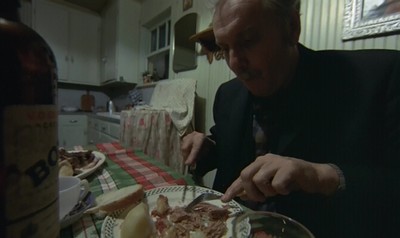
Ending: The symbolism of the ending is both subtle and poetic. Too drunk to drive after the dinner at Mrs. Poulin’s, Antoine hands over the reins of the horse carried coffin to young Benoît, who, exhilarated by his over-extended responsibility, drives too fast. The coffin falls off the carriage. Antoine is too drunk to help Benoît retrieve the coffin. In his drunken stupor Antoine confesses his fears, failures, and disappointments in life. Young Benoît must take responsibility. He carts Antoine back to town and calls upon Fernand to help him retrieve the coffin. He catches his aunt Cécile sleeping with Fernand, another lesson learned about how adults behave. In the final scene Fernand and Benoît return to look for the coffin holding Marcel’s body, but do not find it. They arrive at the Poulin residence. We clearly see, from Benoît ’s moving POV shot (filmed with an unstable hand-held camera), Fernand walk up the porch to the front door call out for Madame Poulin, look in through the door, then turn away and walk past the camera toward the back of the house. Benoît walks up and rather than going to the door looks in through the window to the left of the door. The scene cuts from a slow zoom-in to Benoît’s face pressed up against the window, to his point of view of what he sees inside. His POV shot has a stylized, smeared, soft focus outer edge, giving it the appearance of an old album photo. The placement of the family, with Jos, kneeling looking into the open coffin at his dead son, and the mother and other children seated around, seems like a perversion (secular) of the Nativity scene, which we saw earlier in the General store front window (Leach, 135). There is much in this scene which makes us read it as Benoît’s pure fantasy. It is clear that Fernand and Benoît do not find the coffin (the sleigh is empty when they arrive at the Poulin’s), so how does it appear in the Poulin kitchen? And hoes Jos appear in the space, when the last time we saw him he was on a train leaving the town? The fantasy mise en scene places Benoît as the one who sees this ‘rebirthed’ Quebec, the ‘new’ nativity.
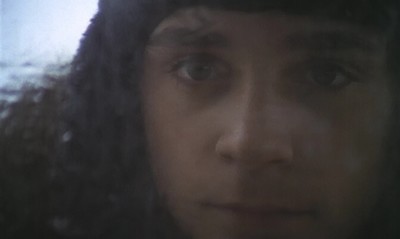
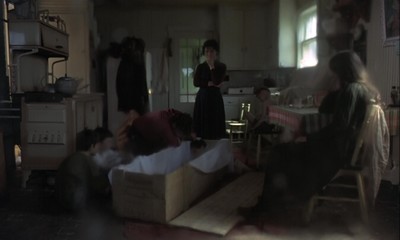
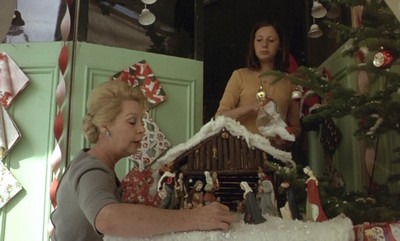
The situation can also be seen within the psyche of a young Benoît who has just witnessed death first hand and while one boy, Marcel, dies, another, Benoît , is “reborn.” Other critics have said that Benoît is like the young version of Jos (Bruce Elder, 198), so he is in a sense looking into his own future; and since that is not ‘possible’ sees his own death.
Is there anything unique about the film?
One of the more continually engrossing aspects of the film is the way it incorporates all forms of rituals – secular, sacred, social, sexual, etc. -the drinking at the bar -Euclide’s funeral -the unveiling of the storefront nativity scene -placing Marcel’s body in the coffin -the final death/Nativity scene in the kitchen -the boss tossing presents to the children -the way Jos leaves at the beginning for the deep woods
All of this says something about the way people need to feel a part of something larger. We can see this also in later Quebec films, like Un Zoo La Nuite, La Confessional, and C.R.A.Z.Y. and perhaps see it as a sublimation of their religious past.
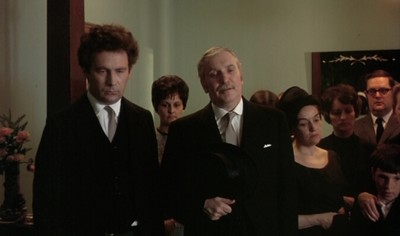
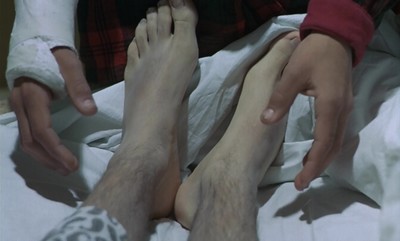
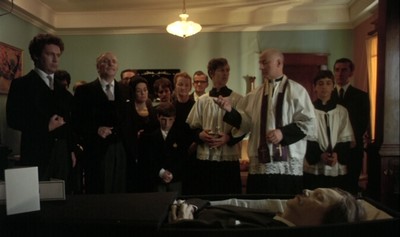
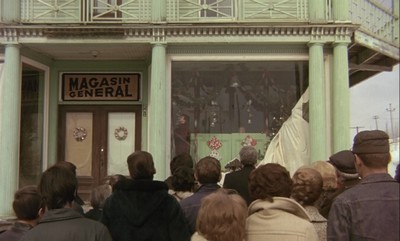
Is there anything that strikes you as particularly Canadian about the film?
Surely the emphasis on an indifferent nature, and death set within this nature is something that has been written about by people like Margaret Atwood in her book Survival and Gail McGregor in The Wacousta Syndrome, which read Canadian art and culture filtered through an awe and reverence for nature and our harsh weather; nature not as a garden, as in American art, but a wilderness. The way that Canada is so spread apart geographically with land that is uninhabitable and with inclement weather leads to what McGregor calls the ‘garrison complex,’ where we are boxed in by nature ; and we can surely see this in Mon oncle Antoine. The final scene is a perfect manifestation of the garrison complex, where Benoît sees his own death.
Jim Leach, in his excellent book on Jutra, Claude Jutra: Filmmaker notes the powerful impact the film’s ending had on Margaret Atwood. Leach quotes the following observation made by Atwood: “If the central European experience is sex and the central mystery ‘what goes on in the bedroom,’ and if the central American experience is killing and the central mystery is ‘what goes on in the forest’….surely the central Canadian central experience is death and the central mystery is ‘what goes on in the coffin’” (134-135). Atwood uses the final scene of Mon Oncle Antoine to exemplify this.

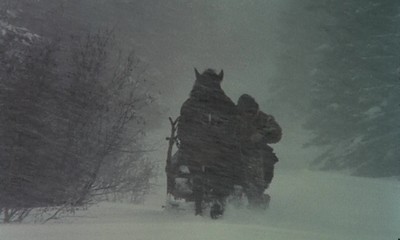
How was the film received critically both at the time, and since?
Timing was critical to the film’s contextualisation. It was made before the Federal governments War Measures Act in Oct. 1970 during the October Crisis, and released after the Act, so it was released during a very volatile period in Quebec history. Perhaps this is why it was deemed by some critics as being ‘out of touch’ with contemporary Quebec issues and current affairs. Although when Mon oncle aired on Radio Canada TV in October 1973 it attracted half the francophone audience; while most of the rest of Canadians saw it on CBC television (about 3 million viewers according to Martin Knelman, 224), so it must have had some current relevancy. It was criticized for being set in the Quebec ‘Dark Ages’ of the Union Nationale, although it is clearly a product of the factors that led to the rise of Quebec Nationalism. Just the mine setting in that time alone makes it political because of the well known strikes. The “Je me souviens” slogan on Quebec car license plates is a reminder to not forget the past, which is what Jutra said in defense of his film: to move forward you must look into your cultural past –a film about his own “sociological and cultural reality” (Melnyk, 139).
In English Canada, reviews were mainly positive and the negative ones focused on what they felt was an ineffectual blending of documentary elements with fiction (Leach, 125). At a higher critical level there was a discussion about whether the film had resorted too much to classical narrative structure, and renounced Jutra’s past formal complexities as direct cinema and poetic/avant-garde filmmaker (Leach, 124). Otherwise, it was very well received both critically and by audiences and its value has, of course, grown immensely over time. In 1997 Mon oncle Antoine Was commemorated on a postage stamp honoring Canadian cinema. In 1999 the Quebec movie industry broke with Toronto-based Genie Awards to form its own awards, and named them after the director of Mon oncle Antoine, the Jutras (Melnyk, 140). There was also a movie theatre (in the hallowed national cinema archive, La Cinémathèque Québécoise) and a park named after Jutra.
What factors contribute to the film’s lasting power?
A large part of its lasting power resides in its disarming complexity. The film appears simple on the surface but is quite complex when you study it closely, and begin to realize how scenes echo each other, how visual motifs mount, and how richly layered it is thematically.
To summarize:
The film can be read in many ways: like the unresolved ending which can be seen as anticipating the Quiet Revolution (the ‘birth’ of a new religion, Nationalism), or of being fatalistic, showing Benoît trapped in his community/social box, the garrison complex; a third reading could be more simply of a young man, or boy turning to adulthood, trying to establish his own identity, selfhood, within a communal setting where everyone is connected through ritual and custom to other people. It can also be seen, as some critics did, as a nostalgic look at a past no longer.
It not only has a universal potential, in the coming of age story, but a specificity to the mining incident of the 1940s; this universality is also in the temporal play of the film, because there are no identifiable temporal markers in terms of clothes, cars, signs, etc, which led some critics to see it as being contemporary with when it was made; and Jutra’s decision to have the title caption which reads “In the asbestos region in the land of Quebec…not too long ago” gives it a fable or fairytale feel, which was no doubt intentional.
The film is filled with subtle visual power, exemplified across the many visual motifs:
1) Images of people looking or being seen through windows:
-workers and children at the General store waiting for the unveiling of the annual Nativity scene, which echoes final scene where Benoît stands outside the window looking into the Poulin kitchen
-the scene where we see Antoine and Cecile talking to each other for the first time, where they have a drink and he complements her
-when M. Poulin calls the store to tell them about Marcel’s death the camera frames Fernand from outside through a window
-during the scene of the English boss delivering presents we get many shots of people inside looking out through doors and windows
-all this ‘looking’ from within is another reflection of the “Garrison complex”
2) The motif of Benoît looking/spying can be seen as an indicator of his search for identity
-at Antoine/Cécile behind a glass partition in their shop
-at Madame Alexandrine trying on a new girdle
-at Carmen trying on wedding veil
-at Fernand & Cécile kissing on couch
-into the Poulin kitchen at the end
3) The impotent male:
-Jos who has to leave his home for work
-Benoît ’s cast on his hand (we never know how he got it)
-Antoine the alcoholic, cuckold husband with no children
-Fernand, who seems to have sexual power, but at the bequest of the frustrated Cécile
4) Childhood sexuality/death
“Religion, sex, and death” (Melnyk, 139) could be the film’s subtitle. The scene where Benoît fondles Carmen and then chases her around the room full of coffins, is as striking a visual association of sex with death as you’ll see. This bit of dark sexual humor gets comically replayed in his sexual fantasy, where the sultry Madame Alexandrine (played with just a hint of cartoon character pizzazz by Monique Mercure) pops out of a coffin.
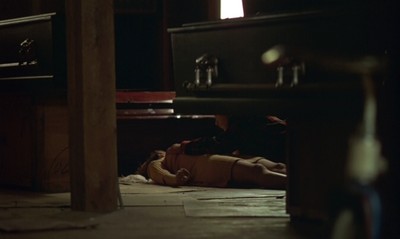
Mon oncle Antoine is a film that has aged very gracefully, and continues to be lauded as one of the greatest Canadian/Quebecois films ever made. Every poll taken by Canadian film critics or magazines always finds it in the Top 10, usually at the top. In many respects it has grown in all the important senses in which we value great cinema: entertainment, social/cultural relevance, and aesthetic. Irony is one of the most difficult dramatic devices to excel in, and Mon oncle Antoine succeeds by depicting the death of pre-Quiet Revolution, rural Quebec ‘innocence’ through a sardonic, at times caustic gaze, but with a hint of nostalgia that gives it an emotional (and poetic) resonance. It is fitting that Mon oncle Antoine is the first Quebec film to receive the full bells and whistle Criterion DVD release, in 2008. The two-disc DVD set is a must buy, with an excellent enhanced for widescreen 1.66 transfer supervised by DP Michel Brault, an excellent 50-minute documentary on the film’s history, On-Screen: Mon Oncle Antoine, a full-length 2002 documentary, Claude Jutra: An Unfinished Story (by Paul Baigerreon), and other features.
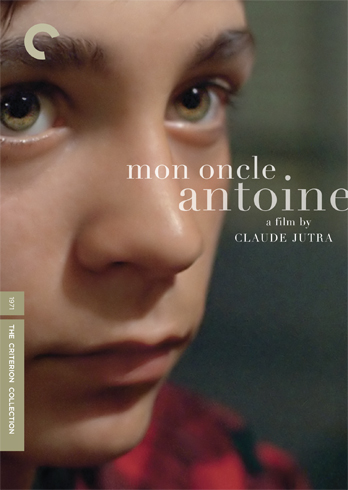
Endnotes
1 For those unfamiliar with Quebec history, the ‘Quiet Revolution’ refers to changes that occurred across the board in Quebec during the 1960s which saw the incumbent hierarchy of Roman Catholic, ultra conservative, rural-driven politics give way to a liberal, modernized social welfare state where the provincial government gained control over more and more cultural and economic areas, such as education, natural resources (Hydro Quebec). As a result there was a shift in power from English to French hierarchy.
Works Cited
Black, Peter. “Inside Quebec: Apostrophe Politics” Log Cabin Chronicles.
Leach, Jim. Claude Jutra: Filmmaker. Montreal & Kingston: McGill-Queen’s University Press, 1999.
Knelman, Martin. This is Where We Came In. Toronto: McClelland and Stewart, c1977.
Melnyk, George. One Hundred Years of Canadian Cinema. Toronto, Buffalo, London: University of Toronto Press Inc., 2004




